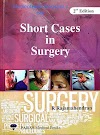What is Cataract?
The word ‘cataract’ dates from the Middle Ages and has been derived from the Greek word ‘katarraktes’ which means ‘waterfall’. This term was coined assuming that an ‘abnormal humour’ developed and flowed in front of the lens to decrease the vision.
As of today, the term cataract refers to development of any opacity in the lens or its capsule. Cataract, thus may occur, either due to formation of opaque lens fibres (congenital and developmental cataracts) or due to degenerative process leading to opacification of the normally formed transparent lens fibres (acquired cataract).
Clinically, the term cataract refers to an opacification of sufficient severity to impair the vision (Dorland’s Illustrated Medical Dictionary, W.B. Saunders, Philadelphia).
In simple words Cataract is the opacity in the lens and it's capsule.
Pathogenesis of Cataract:
It is basically different in nuclear and cortical senile cataracts.
1. Cortical senile cataract:
Its main biochemical features are decreased levels in the crystalline lens of total proteins, amino acids and potassium associated with increased concentration of sodium and marked hydration of the lens, followed by coagulation of lens proteins. The probable course of events leading to senile opacification of cortex.
2. Nuclear senile cataract:
In this the usual degenerative changes are intensification of the age-related nuclear sclerosis associated with dehydration and compaction of the nucleus resulting in a hard cataract. It is accompanied by a significant increase in water insoluble proteins. However, the total protein content and distribution of cations remain normal. There may or may not be associated deposition of pigment urochrome and/or melanin derived from amino acids in the lens.
Classification:
A. Etiological classification
I. Congenital and developmental cataract
II. Acquired cataract
1. Senile cataract
2. Traumatic cataract (see page 429)
3. Complicated cataract
4. Metabolic cataract
5. Electric cataract
6. Radiational cataract
7. Toxic cataract e.g.,
i. Corticosteroid-induced cataract
ii. Miotics-induced cataract
iii. Copper (in chalcosis) and iron (in siderosis)
induced cataract
8. Dermatogenic cataract
9. Cataract associated with osseous diseases
10. Cataract with miscellaneous syndromes e.g.,
i. Dystrophica myotonica
ii. Down’s syndrome
iii.Lowe’s syndrome
iv. Treacher-Collin’s syndrome.
Morphological classification:
1. Capsular cataract. It involves the capsule and may be,
i. Anterior capsular cataract
ii. Posterior capsular cataract
2. Subcapsular cataract. It involves the superficial most part of the cortex (just below the capsule) and includes:
i. Anterior subcapsular cataract
ii. Posterior subcapsular cataract
3. Cortical cataract. It involves the major part of the cortex.
4. Supranuclear cataract. It involves only the deeper parts of cortex (just outside the nucleus).
5. Nuclear cataract. It involves the nucleus of the crystalline lens.
6. Polar cataract. It involves the capsule and superficial part of the cortex in the polar region only and may be:
i. Anterior polar cataract
ii. Posterior polar cataract
Management of Cataract:
Treatment of cataract essentially consists of its surgical removal. However, certain nonsurgical measures may be of help, in peculiar circumstances, till surgery is taken up.
A. Non - surgical measures:
1. Treatment of cause of cataract.In acquired cataracts, thorough search should be made to find out the cause of cataract. Treatment of the causative disease, many a time, may stop progression and sometimes in
early stages may cause even regression of cataractous changes and thus defer the surgical treatment. Some common examples include:
• Adequate control of diabetes mellitus, when discovered.
• Removal of cataractogenic drugs such as corticosteroids, phenothiazenes and strong miotics, may delay or prevent cataractogenesis.
• Removal of irradiation (infrared or X-rays) may also delay or prevent cataract formation.
• Early and adequate treatment of ocular diseases like uveitis may prevent occurrence of complicated cataract.
2. Measures to delay progression include:
• Topical preparations containing iodide salts of calcium and potassium are being prescribed in abundance in early stages of cataract (especially in senile cataract) in a bid to delay its progression.
• However, till date no conclusive results about their role are available.
• Role of vitamin E and aspirin in delaying the process of cataractogenesis is also mentioned.
3.Measures to improve vision in the presence of incipient and immature cataract may be of great solace to the patient. These include:
• Prescription of glasses refractive status, which often changes with considerable rapidity in patients with cataract, should be corrected at frequent intervals.
• Arrangement of illumination. Patients with peripheral opacities (pupillary area still free), may be instructed to use brilliant illumination.
• Conversely, in the presence of central opacities, a dull light placed beside and slightly behind the patient’s head will give the best result.
• Use of dark goggles in patients with central opacities is of great value and comfort when worn outdoors.
• Mydriatics. Patients with a small axial cataract, frequently may benefit from papillary dilatation.
This allows the clear paraxial lens to participate in light transmission, image formation and focussing.
Mydriatics such as 5% phenylephrine or 1% tropicamide; 1 drop b.i.d. in the affected eye may clarify vision.
B. Surgical management:
I. Intracapsular cataract extraction (ICCE)
In this technique, the entire cataractous lens along with the intact capsule is removed. Therefore, weak and degenerated zonules are a pre-requisite for this method.
Indications. ICCE has stood the test of time and had been widely employed for about 100 years over the world (1880-1980). Now (for the last 35 years) it has been almost entirely replaced by planned extracapsular techniques.
At present the only indication ofICCE is markedly subluxated and dislocated lens.
II. Extracapsular cataract extraction techniques
In these techniques, major portion of anterior capsule with epithelium, nucleus and cortex are removed; leaving behind the intact posterior capsule.
Indications: Presently, extracapsular cataract extraction techniques are the surgery of choice for almost all types of adulthood as well as childhood cataracts unless contraindicated. Contraindications: The only absolute contraindication for ECCE is markedly subluxated or dislocated lens.
Advantages of ECCE techniques over ICCE include:
1. ECCE is a universal operation and can be performed at all ages, except when zonules are not intact; whereas ICCE cannot be performed below 40 years of age.
2. Posterior chamber IOL can be implanted after ECCE, while it cannot be implanted after ICCE.
3. Postoperative vitreous related problems (such as herniation in anterior chamber, pupillary block and vitreous touch syndrome) associated with ICCE are not seen after ECCE.
4. Incidence of postoperative complications such as endophthalmitis, cystoid macular oedema and retinal detachment are much less after ECCE as compared to that after ICCE.
5. Postoperative astigmatism is less with ECCE techniques, as the incision is smaller.
6. Prognosis for subsequent glaucoma filtering or corneal transplantation (if required) is much improved with ECCE.
7. Incidence of secondary rubeosis in diabetics is reduced after ECCE.
Different techniques of extracapsular cataract extraction
The surgical techniques of ECCE presently in vogue are:
• Conventional extracapsular cataract extraction (ECCE),
• Manual small incision cataract surgery (SICS),
• Phacoemulsification.










Social Plugin